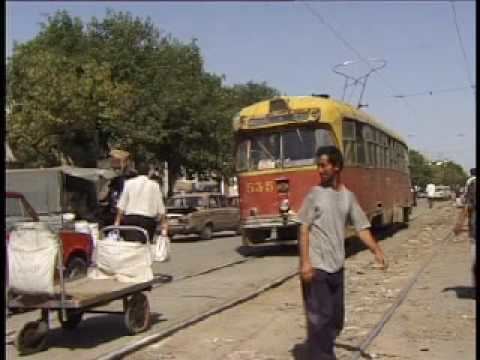 | ||
The Baku tramway network was a network of tramways forming part of the public transport system in Baku, now the capital city of Azerbaijan, between 1889 and 2004.
Contents
Early tramways
The first tramway in Baku was a cable powered line, opened in 1887. It was used for passenger traffic and was later named "Chernogorodskaya" (Russian for "Black city" ). On 7 April (19 April) 1889, a horsecar line was opened. The owner of that line took over the Chernogorodskaya line, and converted it to horsecar operation.
Some five months later, on 24 September (6 October) 1889, the horsecar tramway was supplemented by a steam tramway. However, the steam tramway did not last very long. Competition from the horsecar tramway made it unprofitable, and it was closed in about 1894 and transformed into another horsecar tramway.
The Baku horsecar tramway was built to 1,524 mm (5 ft) gauge. There were also freight tramways laid between various enterprises around the city.
By the start of the 20th century, the horsecars were already unable to cope with growing volumes of passenger traffic in the oil industry centre of the Russian Empire. In 1903, the City Council received a proposal for the construction of a Baku electric tramway. For the next 20 years, the city bureaucracy created numerous commissions, and developed projects and budgets, until 1922, when the Council began planning the construction of an electric tramway network.
Meanwhile, Baku continued to be served by horsecar trams until the horsecar network was closed on 1 October 1923.
Electric tramway
On 8 February 1924, an electric tramway was opened in Baku. The electric tramway network lasted until January 2004.
In February 2012, the government of Azerbaijan announced that it is planning to restore the tramway in Baku after dismantling it only eight years ago. A new tramway line will be laid along the seaside promenade of Baku Boulevard in central Baku as part of the "Baku White City" development project. Unlike the former tramway network, the new tramway network will be considerably shorter in length and it will not serve within the main road networks of Baku as was the case with the former tramway network; but it will instead run along the seaside promenade thus not clashing with the road traffic.
Lines
As of 1972, the electric tramway network's lines (with destinations in Russian) were as follows:
By the end of the 1980s, the network's lines (with destinations in Russian) had become:
As of 2004, the only remaining line was line 6.
